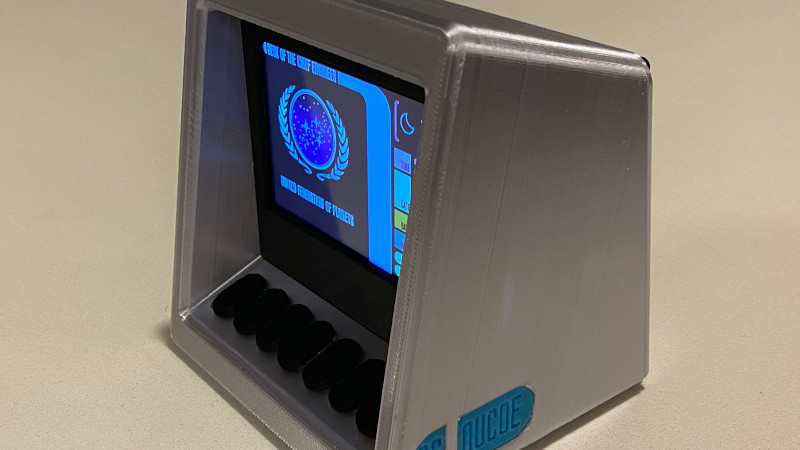It could be said that there are two types of people: those for whom the actor LeVar Burton is the host of Reading Rainbow, and those for whom he is Geordi LaForge, Chief Engineer of Star Trek TNG‘s Enterprise NCC1701-D. For those of us engineers who lie in the second camp, we can at least feel a little closer to the action thanks to a project from [Darian Johnson], a Star Trek TNG mini-computer which functions as a desktop information display.
Inside the 3D-printed case is an ESP32 version of the Adafruit Feather, talking to cloud services to pull in and aggregate the information on the TFT screen. It combines weather data, environmental sensor readings, his fitness tracker readings, and his schedule, with two useful applications. There’s a resistor colour code chart, and an LED series resistor calculator. He’s made a video showing it in operation which we’ve placed below the break, and in it, he’s captured the aesthetic of the LCARS interface perfectly. We can’t speak for a fictional future spacecraft officer, but we suspect that Geordi would be right at home with it.
We may not be able to bring you Geordi LaForge, but we can bring you a real Starfleet officer. She even shares something with LeVar Burton, in that she’s (much more) famous for something else.
















nice build but…
am I the only person that thinks that the LCARS layout is a terrible waste of screen space? huge areas are just a flat colour that does nothing but get in the way….
Well we mostly saw it spread over huge areas of monitors. While some comm panels etc defaulted to that interface for simple functions, when you saw a workstation/desktop that someone was doing heavy numberwork at, they had a more compact interface with only a top bar or sidebar.
hackaday.io has had the same “feature” for its entire life, ignoring the fact that screens got wider, not taller.
but to stay on topic, very beautiful build
It is inspired on the frontpanel of a PDP-11/70 where it was just there to provide coloured switch labels.
For a touch screen it is totally useless but nevertheless a nice homage to the PDP.
And since I am far over 50 I only care about the original series where the only real chief engineering is scotty and the computers have lots of blinkenlights and bleeping sounds.
Now I will start up my PIDP-11.
And this is by design. The purpose of LCARS was to apear futuristic and complex, while at the same time not requiring puting together a lot of information. So the ratio of bling per information unit is sky high.
But hey, it was designed for a TV show!
True, not designed to be efficient when you’re right in front of it, more designed to look spiffy when it was occupying only 100 pixels of TV picture width in the background.
None, you are absolutely right. The layout was designed to read great from a distance, in the background, and blurry, so it was important to go broad and stylistic. It succeeds in looking imaginative, organized, and that it’s saying something important. It’s the number 1 screen save at JPL, so there you go!
3. Kunta Kinte.
I was going to say something about this. Arguably, his most important role. But, there is a fourth type of person. The person who sees him as all three at the same time. He will forever be Kunta Kinte, The Reading Rainbow Guy, and Unlucky In Love Geordi LaForge.
“It could be said that there are two types of people: those for whom the actor LeVar Burton is the host of Reading Rainbow, and those for whom he is Geordi LaForge, Chief Engineer of Star Trek TNG‘s Enterprise NCC1701-D.”
It could also be said that they’re separate bits; for me, he was both.
He was also the person who took the publicly funded Reading Rainbow and stuck it behind a paywall.
PBS dropped the show, LeVar kept it going online.
Some of us remember when he was “the guy from Roots”.
The shiw would have peripheral material to the book being read. One time the footage was from a snack cake factory, very interesting to see. I didn’t watch tge show much, I was too.old. But those “live footage” were interesting, even if I can’t remember another example.
That’s pretty misleading, he didn’t “take” the publicly funded show, the public chose to stop funding it.
“public” as in a corporate entity that decides what it will tell the real public.
Nice, but there was an LCARS Toy Bank made in ’94 that looked much cooler, here’s a picture…
https://www.picclickimg.com/d/l400/pict/202910088637_/Star-Trek-the-Next-Generation-Electronic-Console-Bank.jpg
it would be a perfect case for this. (Or if someone could remake a 3D printer design for it all the better.)
yeah i thought it was an interesting artistic choice…the case in this project looks more like a TOS computer than anything else, while the UI is clearly TNG LCARS. seemed weird to me because we’re finally to the era where even a hobbyist project can be shoe-horned into just about any form factor. a lot of the stuff that looked futuristically thin in TNG now looks thick compared to the modern state of the art.
I would wager there are a fare few few of us that “can go twice as high” and “boldly go where no one has gone before”
I’m getting to that age where I’m baldly going now.
But, Picard was the first, (even though the 23rd Century has not occurred yet)
B^)
I saw this thing and immediately heard the door chime in my head.